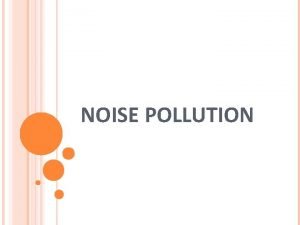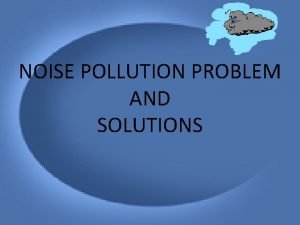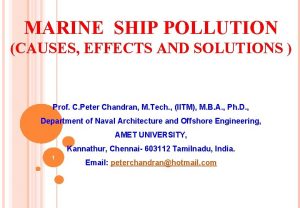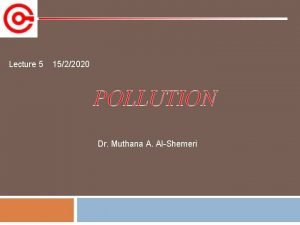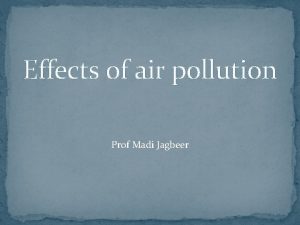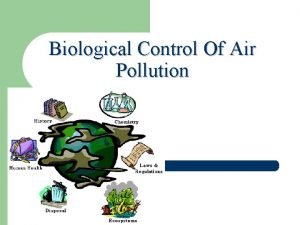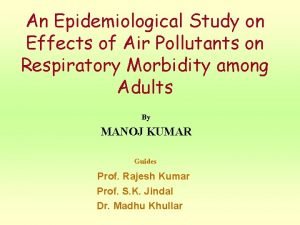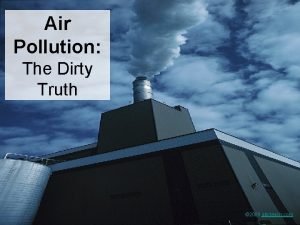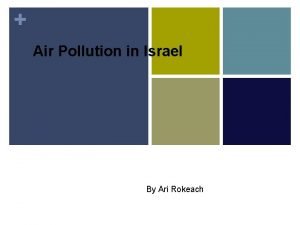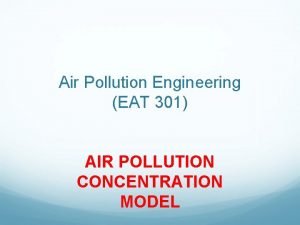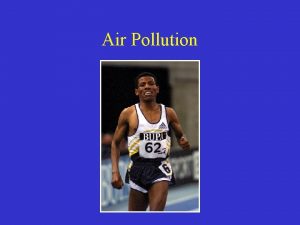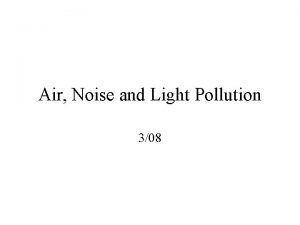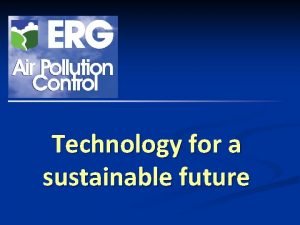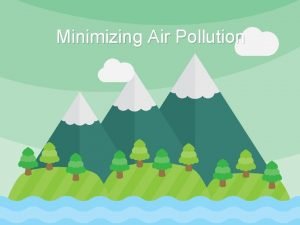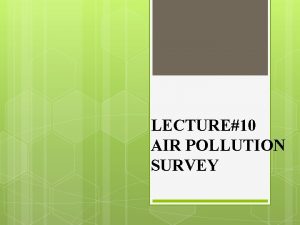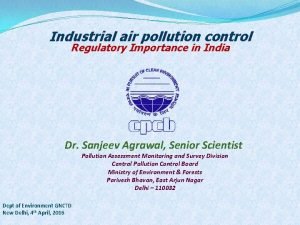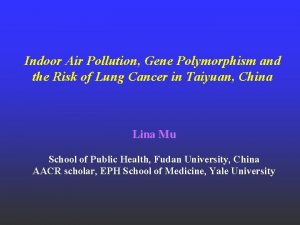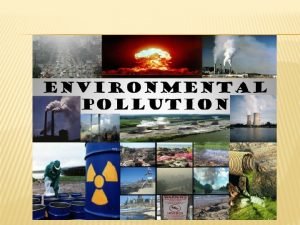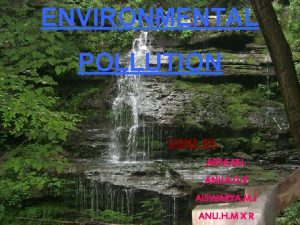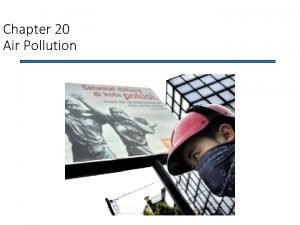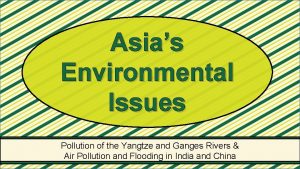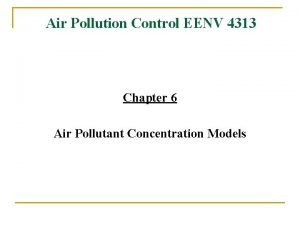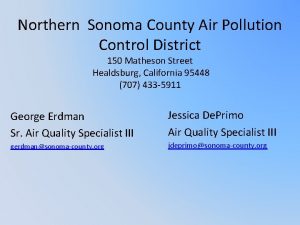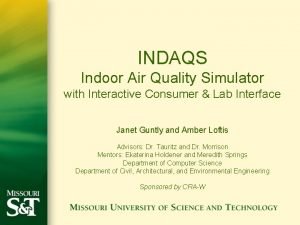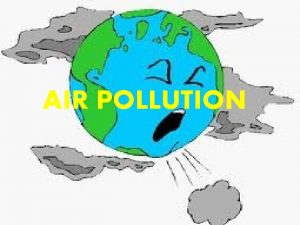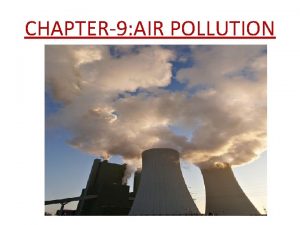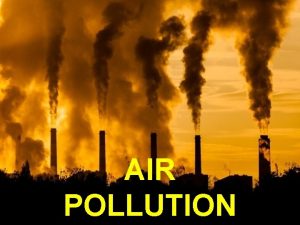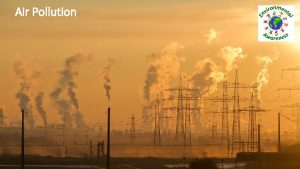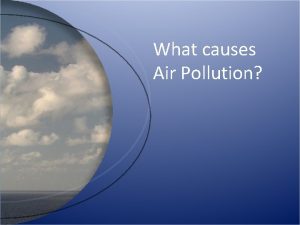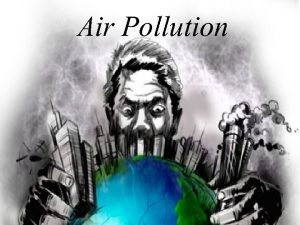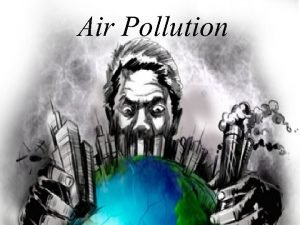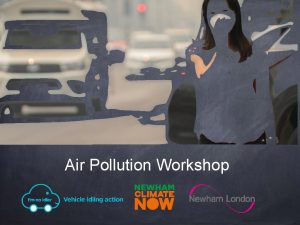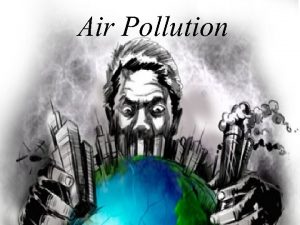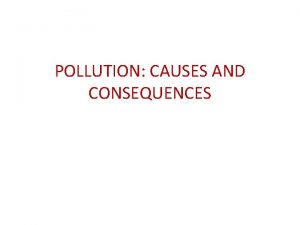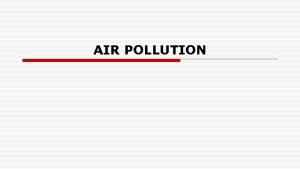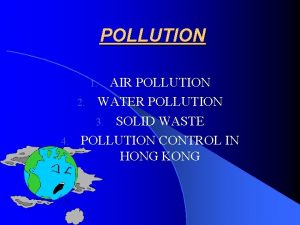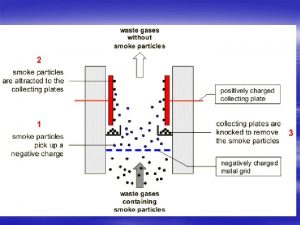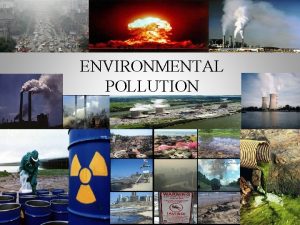CHAPTER 12 1 What Causes Air Pollution WARMUP
















































- Slides: 48

CHAPTER 12 -1 What Causes Air Pollution?

WARM-UP

LAYERS OF THE ATMOSPHERE • Four layers: • Troposphere • Stratosphere • Mesosphere • Thermosphere

TROPOSPHERE • Densest of the atmospheric layers • Almost all weather occurs here

STRATOSPHERE • Ozone layer (O 3) • Ozone absorbs UV radiation • 3 O 2 + UV 2 O 3



MESOSPHERE • Very cold! • Meteorites

THERMOSPHERE • Very high temperatures • Absorbs harmful solar radiation (X rays and gamma rays)

TEMPERATURE IN THE ATMOSPHERE

WHAT CAUSES AIR POLLUTION? • Air pollution: the contamination of the atmosphere by wastes from sources such as industrial burning and automobile exhausts. • Solids, liquids, or gases. • Most air pollution is the result of human activities

WHAT CAUSES AIR POLLUTION? • Some natural: dust, pollen, spores, and sulfur dioxide from volcanic eruptions • Condensation nuclei

CATEGORIES OF AIR POLLUTANTS • Primary pollutants • Emitted directly from natural sources or human activities • Ex. CO, CO 2, SO 2, NO 2 • Secondary pollutants • Occur when primary pollutants react with one another to form new harmful chemicals • Ex. H 2 SO 4, O 3, HNO 3

MAJOR OUTDOOR AIR POLLUTANTS • Carbon oxides: • Carbon monoxide (CO) • Harmful to human health • Vehicle exhaust • Carbon dioxide (CO 2) • Released from burning fossil fuels • Deforestation • Contributing to climate change

MAJOR OUTDOOR AIR POLLUTANTS • NOx (nitrogen oxide and nitrogen dioxide) • Nitrogen oxide (NO) • Automobile engines • Coal burning power plants • Nitrogen dioxide (NO 2) • Can form nitric acid (acid rain) • NOx play a role in the formation of photochemical smog

MAJOR OUTDOOR AIR POLLUTANTS • SOx (sulfur dioxide and sulfuric acid) • Sulfur dioxide (SO 2) • Combustion of coal • Oil refining • Sulfuric acid (H 2 SO 4) • Contributes to acid deposition

MAJOR OUTDOOR AIR POLLUTANTS • Particulates • Suspended particulate matter (SPM) – consists of a variety of solid particles and liquid droplets. Remain suspended in air. • Fine (PM – 10) • Ultrafine (PM – 2. 5) • Sources • Natural – dust, wildfires, sea salt • Human – coal burning power plants, motor vehicles

MAJOR OUTDOOR AIR POLLUTANTS

MAJOR OUTDOOR AIR POLLUTANTS • Ozone (O 3) • Major component of photochemical smog • Tropospheric ozone “bad ozone” • Volatile organic compounds (VOCs) • Hydrocarbons • Long term exposure may result in cancer

MAJOR OUTDOOR AIR POLLUTANTS

WARM UP • What is the difference between a primary and secondary air pollutant? (How are they defined? ) • Provide an example of each

SECONDARY POLLUTANT FORMATION

PRIMARY POLLUTANTS

HISTORY OF AIR POLLUTION • The world’s air quality problem is much worse today because modern industrial societies burn large amounts of fossil fuels. • Most air pollution in urban areas comes from vehicles and industry. • London Smog

MOTOR VEHICLE EMISSIONS • Almost 1/3 of our air pollution comes from gasoline burned by vehicles. • Over 90% of that mileage was driven by passenger vehicles. • The rest was driven by trucks and buses.

CONTROLLING VEHICLE EMISSIONS • The Clean Air Act (1970, strengthened in 1990) • Environmental Protection Agency (EPA) the authority to regulate vehicle emissions in the USA • Gradual elimination of lead in gasoline • Catalytic converters required in all automobiles

CONTROLLING VEHICLE EMISSIONS

CALIFORNIA ZERO-EMISSION VEHICLE PROGRAM • In 1990, the California Air Resources Board established the zeroemission vehicle (ZEV) program. • Zero-emission vehicles are vehicles that have no tailpipe emissions, no emissions from gasoline, and no emission-control systems that deteriorate over time. • By 2016, 16 percent of all vehicles sold in California are required to be zero-emission vehicles, including SUVs and trucks.

CALIFORNIA ZERO-EMISSION VEHICLE PROGRAM • ZEVs: • Electric vehicles • Hydrogen fuel cells vehicles • Hybrid-electric cars (Partial ZEV)

HOW HYDROGEN FUEL CELL WORKS • https: //www. youtube. com/watch? v=tajig. Z 2 e 6 t. Q

INDUSTRIAL AIR POLLUTION • Power plants that generate our electricity must burn fuel to generate energy • Burning fossil fuels releases huge quantities of SO 2 and NOx • Emit at least 2/3 of all SO 2 • More than 1/3 of all NOx

INDUSTRIAL AIR POLLUTION • https: //www. youtube. com/watch? v=20 Vb 6 hl. LQSg • https: //www. youtube. com/watch? v=-ZBNNcczm. DM

REGULATING AIR POLLUTION FROM INDUSTRY • The Clean Air Act requires many industries to use scrubbers or other pollution-control devices. • Scrubbers: a machine that moves gases through a spray of water that dissolves many pollutants. • Remove some of the more harmful substances • Ammonia (NH 3) & Hydrochloric Acid (HCl)

REGULATING AIR POLLUTION FROM INDUSTRY

REGULATING AIR POLLUTION FROM INDUSTRY • Electrostatic precipitators: machines used in cement factories and coal -burning power plants to remove dust particles from smokestacks. • Gas containing dust particles is blown through a chamber containing an electrical current. • An electric charge is transferred to the dust particles, causing them to stick together and to the sides of the chamber.

REGULATING AIR POLLUTION FROM INDUSTRY • The clean gas is released from the chamber and the concentrated dust particles can then be collected and removed. • Electrostatic precipitators remove 20 million tons of ash generated by coal -burning power plants from the air annually in the USA

SMOG • Smog: urban air pollution composed of a mixture of smoke and fog produced from industrial pollutants and burning fuels. • Two general types of smog • Gray-air smog (Industrial smog) • Brown-air smog (Photochemical smog)

BURNING COAL PRODUCES INDUSTRIAL SMOG • Chemical composition of industrial smog • Sulfur dioxide (SO 2), suspended particles, sulfuric acid (H 2 SO 4) • Gray-air smog • Reduction of this smog in urban cities of the United States, still a problem in China

INDUSTRIAL SMOG (GRAY-AIR SMOG)

SUNLIGHT PLUS CARS EQUALS PHOTOCHEMICAL SMOG • Photochemical Smog • Mixture of primary and secondary pollutants under the influence of Ultraviolet (UV) radiation from sun • VOCs + NO 2 + Heat + Sunlight yields • Ground level O 3 and other photochemical pollutants Exhaust from motor vehicles

PHOTOCHEMICAL SMOG IN SANTIAGO, CHILE

TEMPERATURE INVERSIONS • During the day, the sun heats the surface of the Earth and the air near the Earth. • The warm air rises through the cooler air above it and carries pollutants away from the ground, and into the atmosphere. • Sometimes pollution is trapped near the Earth’s surface by a temperature inversion.

TEMPERATURE INVERSIONS • Temperature inversion: an atmospheric condition in which warm air traps cooler air near Earth’s surface. • The warmer air above keeps the cooler air at the surface from moving upward. So, pollutants are trapped below with the cooler air.

TEMPERATURE INVERSIONS • If a city is located in a valley, it has a greater chance of experiencing temperature inversions. • Los Angeles, surrounded on three sides by mountains, often has temperature inversions.

DONORA, PA (1948)

AIR POLLUTION DATA LAB • AQI = Air Quality Index • Updated link: https: //www. epa. gov/outdoor-air-quality-data/air-data-aqi-plot • Follow the Procedure to complete the chart under the given years (1980 & 2013) • You can choose any pollutant you wish but please indicate your choices for first and second pollutant on your lab sheet chart • For each pollutant you fill in the number indicated for each pollutant on you AQI chart for good, moderate, unhealthy “sensitive”, unhealthy, & very unhealthy • Complete the analysis questions on the back of your lab sheet

WARM-UP • What is another name for gray-air smog? How does it form? • What is another name for brown-air smog? How does it form?

MATH PRACTICE
 Section 1 what causes air pollution answer key
Section 1 what causes air pollution answer key Chapter 12 air section 1 what causes air pollution
Chapter 12 air section 1 what causes air pollution Hubungan air tanah dan tanaman
Hubungan air tanah dan tanaman Warmup ratio
Warmup ratio Warmup 65
Warmup 65 Gmass warmup
Gmass warmup Status vs class
Status vs class Pyramid warmup
Pyramid warmup Identical rhyme examples
Identical rhyme examples Multiplying exponents with same base
Multiplying exponents with same base Java warmup
Java warmup Define:warmup
Define:warmup Pathos story
Pathos story Tinman warm up
Tinman warm up Warmup 65
Warmup 65 Warmup end
Warmup end Pollution causes effects and solutions
Pollution causes effects and solutions Solution
Solution Problems of noise pollution
Problems of noise pollution Marine noise pollution
Marine noise pollution Land pollution effects on human health
Land pollution effects on human health Cause of noise pollution
Cause of noise pollution Proximate causation vs ultimate causation
Proximate causation vs ultimate causation Altruistic behavior
Altruistic behavior 8 effects of water pollution
8 effects of water pollution Land water and air pollution
Land water and air pollution Introduction about air pollution
Introduction about air pollution Effects of air pollution in plants
Effects of air pollution in plants Air pollution contents
Air pollution contents Aims and objectives of air pollution
Aims and objectives of air pollution Main cause of air pollution
Main cause of air pollution Primary and secondary pollutants
Primary and secondary pollutants Ari rokeach
Ari rokeach Air pollution box model example
Air pollution box model example General effects of air pollution
General effects of air pollution Air pollution consequences
Air pollution consequences Erg air pollution control
Erg air pollution control Air pollution
Air pollution Objectives of air pollution
Objectives of air pollution Air pollution means
Air pollution means Air pollution
Air pollution Inorganic pollution
Inorganic pollution Objective of environmental pollution
Objective of environmental pollution Sources of smog
Sources of smog 5 effects of air pollution
5 effects of air pollution Air pollution control engineering noel de nevers solution
Air pollution control engineering noel de nevers solution Northern sonoma county air pollution control district
Northern sonoma county air pollution control district Indoor air pollution examples
Indoor air pollution examples Air pollution simulator
Air pollution simulator

















